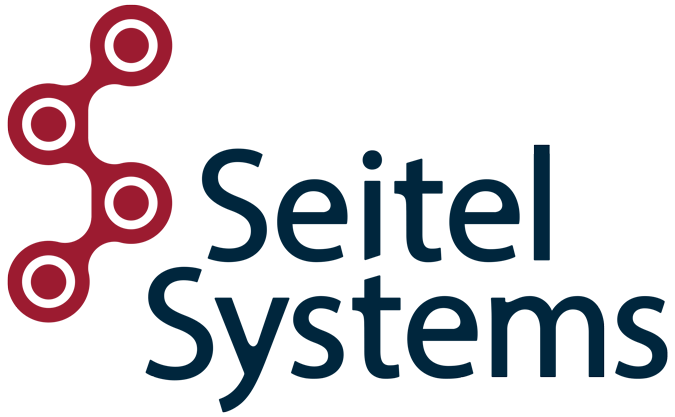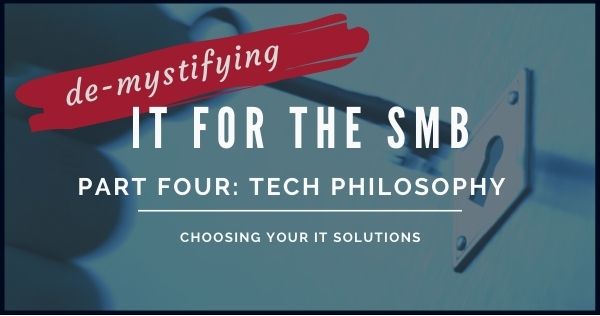In this series so far, we’ve learned about IT Maturity and the three aspects of successful IT in the SMB world: people, processes, and technologies. Today we’re diving into technologies, highlighting technology decisions that SMBs face, and setting a few guiding principles that will help you ensure you’re choosing the right systems with a long-term view.
When it comes to choosing the technologies that your business will run on, there are a LOT of questions to ask – so many that it can make your head spin. These are big decisions that will form the basis of your firm’s operations and the daily work-life experience of your employees for years to come. The choices you make now will have long-term ramifications on your business’ stability and profitability, so it’s important to go into these technology conversations with eyes wide open.
First things first – before you choose your new technologies, make sure you’ve done an IT Assessment so that you understand what you have now, and how well it’s working. You’d be amazed at how many clients come to us for a recommendation on a new system when they don’t even know what they have now and can’t provide us a network diagram! An IT Assessment is crucial so that you can make an informed decision about whether you really just need to upgrade a single system, or whether you’d be heading into a world of trouble if you don’t improve your underlying infrastructure first.
If you’ve got a good handle on all that, then it’s time to start getting into the nitty gritty and build your IT Roadmap – choosing what technology projects you want to take on, and in what order. Every situation will be unique because every business is unique, but there are some tried-and-true approaches that make up our philosophy toward technology. Here’s our quick list of Tech dos and don’ts that help make your decisions a lot clearer.
1. Don’t try to reinvent the wheel, instead…
DO use common, industry-standard business technologies.
Chances are, someone out there has already done what you’re trying to do, so you don’t need to invent something completely new and unique. If you try to reinvent the wheel by “hacking” a solution, or using a product to suit a purpose it wasn’t designed for, you’ll end up with a system that doesn’t perform well and will be unstable in the long run.
Plus, in the event that something breaks and you need support, it will be that much harder for your IT provider to help you because they have to dig deeper to find these unusual configurations so they can fix them. Not to mention that if one of your hacky “fixes” breaks because of software updates that remove or override these settings, you’ll be up the creek without a paddle.
For the same reason, we often discourage our clients from rushing to embrace bleeding-edge technologies before they’ve been road tested by others in the real world. Instead, we recommend implementing common, business standard products that a lot of people know how to support, and will be easier for new eyes to troubleshoot.
2. Don’t always buy the cheapest option, instead . . .
DO invest a bit more in business-grade hardware and software.
Many SMBs are budget-sensitive and have to be cost-conscious. But it’s important to keep a skeptical eye on discounted products that are on sale or clearance (likely for good reason). Often the least expensive product is going to cost you more to support in the long run, because they have lower-performance standards or are legacy products that will be grandfathered out soon by the manufacturer. In the vast majority of cases, you’ll be better off paying a bit more initially so that you’ll get better performance and a degree of future-proofing in the long run.
Specific to hardware, it’s important that your SMB not purchase consumer-grade equipment to save money. Consumer products typically lack the robust functionality, high performance and ease of support that business-grade products offer. Even if they do have comparable tech specs, consumer products will typically be more difficult for business-oriented techs to troubleshoot because they have to do a lot more digging for documentation. The Manufacturer’s troubleshooting guides may be unintelligible or outright nonexistent, and they may or may not have support available.
The same general rule of thumb holds true of hosted services. Azure and AWS are almost always going to be better options than the smaller hosting firms. Rent hosted applications wherever possible rather than purchase/install on your own hardware or in your own private cloud. Nowadays you’re better off working within the business-oriented hosting services, you’ll get much better service levels, support, and security than you could with a self-hosted solution.
Finally, most business products have excellent documentation and help lines for IT techs. There also are relatively fewer products that IT technicians encounter day-to-day, so they come to know these business devices really well.
3. Don’t lock yourself in to proprietary vendor software, instead . . .
DO make sure you understand what your company owns directly versus what your IT Managed Services provider is licensing or leasing to you.
One of the unpleasant surprises that some of our new clients face when they choose to leave their old IT provider is that they don’t actually OWN the software they’ve been using . . . an antivirus solution here, a backup utility there. Sometimes IT Managed Services firms don’t make it clear that they are using proprietary systems, or perhaps even leasing products to you. In either case, that means you will lose access to those products to when you switch IT vendors.
That means when you ultimately decide to go elsewhere, you’ve got a huge headache finding a replacement for a product you didn’t even realize your firm didn’t own. Some less scrupulous firms do this to lock you in to their services and make the hassle of leaving less appealing than putting up with inferior customer service.
Bottom line, be clear on what you own vs what you rent and have a basic understanding of how to replace your rented items if and when you need to make a change.
4. Don’t get locked into a certain IT brand without researching your options, instead . . .
DO seek the advice of someone who doesn’t have a vested interest in selling you a particular product.
This is a case where one size really does not fit all. As you’re interviewing potential IT service providers, you don’t want to get railroaded into a certain product that might not be the best for you. Make sure the solutions you choose work with your key clients and partners.
Ask around in any industry groups you may belong to and see what others are successfully using. For example, Seitel Systems is active in numerous industry groups like PSALA, WDTL, WSCPA, WASWD, ACCIS, and others, so we stay up on the pulse of what’s happening. It’s always a good idea to seek the advice of an IT engineering firm who knows your industry to help select your IT technologies.
IT Industry insider tip: Many IT service firms get manufacturer kickbacks to sell certain products to their clients. When you see “partner” logos on an IT consultant’s website, that generally means that they know those products really well, but it ALSO means that they might have some financial kickbacks from the manufacturer when they resell their products. So it’s important to select an IT firm that will truly recommend the best product for you, and not just the one that’s going to make them the most money.
Seitel Systems is one of the few IT firms out there that doesn’t resell products or accept kickbacks from vendors like Dell, HP, Cisco, etc. When we do partner with manufacturers because we want access to their other support resources we can use for our clients, we specifically opt out of those incentives so we can maintain neutrality in our recommendations. We’ll recommend the technologies we think will really best suit your needs, goals, and budget.
Having a trustworthy IT partner really helps make to make all of these technology decisions a lot easier. As you can see, the choice of IT provider is critical – you want to partner with a firm that thinks about the long game instead of short-term fixes. You want an IT provider that has lengthy client relationships. And you want an IT provider that plays well with others and doesn’t lock you in to their products and services so you can’t leave of your own volition. Choosing an IT provider is like choosing a dentist – you only want to do it once.
By popular request, we’ll be adding one final bonus topic that keeps SMB leaders up at night—cybersecurity. Stay tuned to learn about some key factors that help to keep your business and customer data safe!

